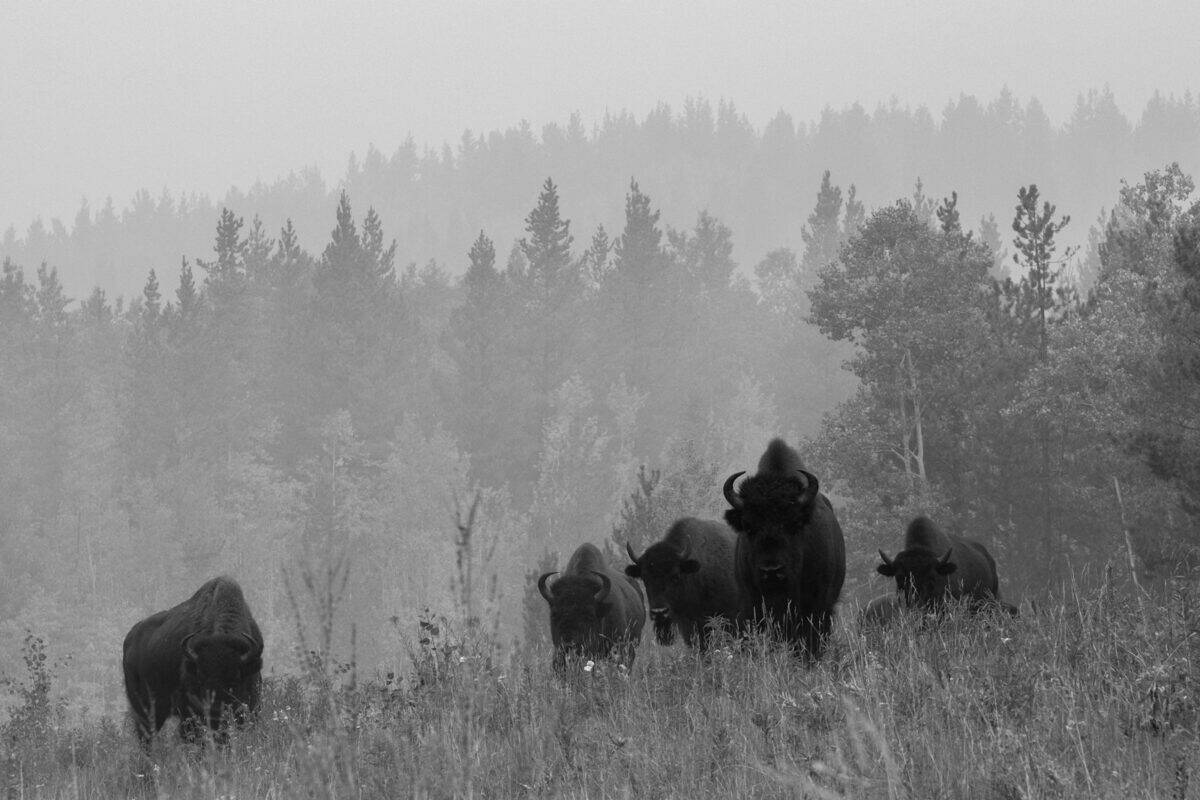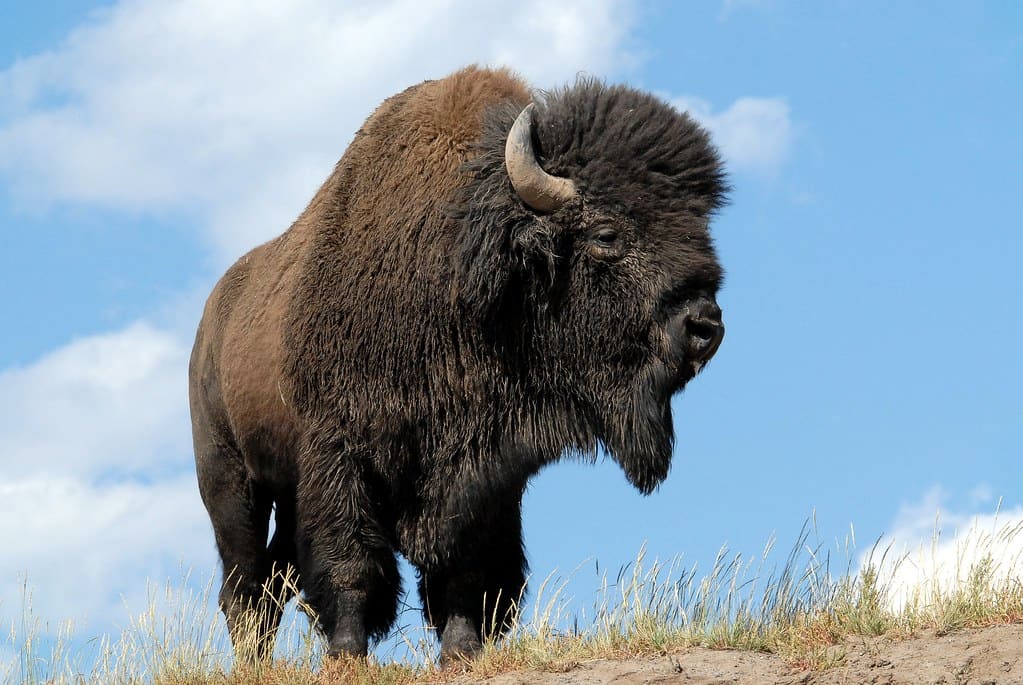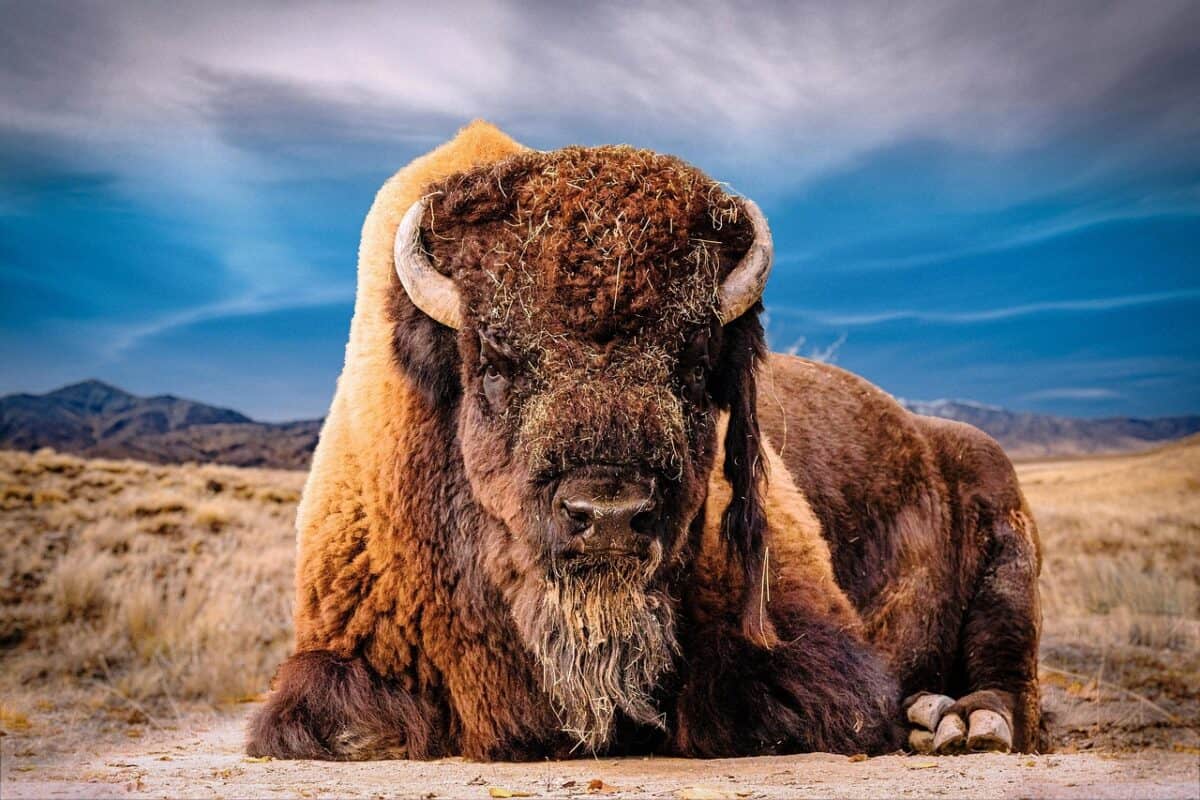Majestic, powerful, and emblematic of the American West, bison once roamed North America in herds numbering in the tens of millions. By the late 1800s, these magnificent creatures were hunted to near extinction, with fewer than 1,000 remaining. Today, thanks to extensive conservation efforts, wild bison populations have rebounded in select protected areas across the United States. National parks serve as vital sanctuaries for these impressive animals, offering visitors the rare opportunity to witness North America’s largest land mammal in its natural habitat. From the iconic plains of Yellowstone to lesser-known preserves, here are 15 national parks where you can experience the awe-inspiring sight of wild bison roaming free.
Yellowstone National Park, Wyoming/Montana/Idaho

Yellowstone National Park is home to America’s oldest and largest public bison herd, with a population fluctuating between 4,000-5,000 animals. These bison are particularly significant as they are among the few that have not been interbred with cattle, representing the most genetically pure bison remaining in North America. The herd descended from just 23 wild bison that remained in the park after the mass slaughter of the 19th century, making their recovery one of the greatest conservation success stories in American history.
Visitors to Yellowstone can readily spot bison in the Lamar and Hayden valleys, where the massive creatures graze across the landscape. During summer months, bison often appear along roadways, creating “bison jams” as tourists slow to observe and photograph them. Winter provides a particularly dramatic backdrop for viewing these hardy animals, as they use their massive heads to sweep away snow to reach the grass beneath. Despite their docile appearance, park officials caution visitors to maintain a safe distance of at least 25 yards, as bison can be unpredictable and charge when feeling threatened.
Grand Teton National Park, Wyoming

Connected to Yellowstone via the John D. Rockefeller Jr. Memorial Parkway, Grand Teton National Park hosts part of the Jackson bison herd, which numbers around 500 animals. The dramatic backdrop of the jagged Teton Range creates some of the most picturesque bison viewing opportunities in the national park system. The herd migrates seasonally between Grand Teton and the National Elk Refuge, with many bison remaining within park boundaries throughout the year.
The best locations for spotting bison in Grand Teton include the sagebrush flats near Antelope Flats Road, Mormon Row, and the Gros Ventre River area. During spring, visitors might witness calving season, when reddish-orange calves stay close to their protective mothers. Grand Teton’s bison management is part of a complex interagency effort that balances conservation goals with the needs of surrounding communities and ranches, as bison occasionally wander beyond park boundaries during seasonal migrations.
Theodore Roosevelt National Park, North Dakota

Named for the president who played a crucial role in early bison conservation, Theodore Roosevelt National Park maintains a herd of approximately 400 bison across its South and North Units. The park’s rolling badlands provide a habitat reminiscent of what Theodore Roosevelt himself experienced when he ranched in the area during the 1880s. The rugged landscape, with its unique geological formations and mixed-grass prairie, offers an authentic glimpse into the historical range of the American bison.
Visitors can often spot bison while driving the scenic loops in both units of the park. The South Unit’s 36-mile loop road provides numerous viewing opportunities, particularly in the early morning or evening hours when the animals are most active. The park conducts periodic roundups to maintain the herd at a sustainable size for the available habitat, with excess animals transferred to tribal nations and other conservation partners. This management approach helps ensure the genetic diversity and health of the herd while restoring bison to additional portions of their historical range.
Badlands National Park, South Dakota

The otherworldly landscape of Badlands National Park serves as home to a herd of approximately 1,200 bison, making it one of the larger populations within the National Park system. These bison roam freely through the park’s mixed-grass prairie, where they share the ecosystem with pronghorn, bighorn sheep, and prairie dogs. The stark beauty of the eroded buttes, pinnacles, and spires creates a dramatic setting for observing these prehistoric-looking mammals as they graze across the grasslands.
The Sage Creek Wilderness Area in the park’s north unit offers the most reliable bison viewing opportunities. Visitors can often spot herds from the Sage Creek Rim Road, an unpaved route that provides access to remote sections of the park. Unlike some other parks, Badlands allows backcountry camping in the bison’s territory, though hikers must maintain appropriate distances from the animals. The park’s bison program includes periodic health assessments and a strong partnership with neighboring tribal lands, particularly the Pine Ridge Reservation, where the Oglala Sioux Tribe maintains its own bison conservation efforts.
Wind Cave National Park, South Dakota

While most famous for its intricate cave system, Wind Cave National Park protects over 33,000 acres of mixed-grass prairie that supports a genetically important bison herd of about 350 animals. These bison are particularly significant to conservation efforts as they possess high levels of genetic diversity and no evidence of cattle gene introgression. This makes the Wind Cave herd one of the most genetically valuable conservation herds in North America, serving as a source population for restoration projects across the continent.
The rolling prairie landscape of Wind Cave provides excellent bison viewing opportunities, especially along the park’s scenic drives and hiking trails. The Rankin Ridge area and the visitor center prairie dog town frequently attract grazing bison. The park implements a unique management approach that mimics natural selection processes, allowing the bison population to self-regulate within the constraints of the fenced park boundaries. This hands-off management philosophy aims to maintain the wild character of the herd while ensuring that the grassland ecosystem remains healthy and diverse.
Tallgrass Prairie National Preserve, Kansas

The Tallgrass Prairie National Preserve protects one of the last remaining expanses of tallgrass prairie in North America, an ecosystem that once covered 170 million acres of the continent. Since 2009, the preserve has been home to a growing bison herd, which now numbers around 100 animals. These bison play a critical ecological role in maintaining the health of the tallgrass ecosystem through their grazing patterns, which help promote plant diversity and create habitat for other prairie species.
Visitors can witness bison grazing among grasses that can reach heights of over six feet, creating a scene reminiscent of the landscape encountered by early European explorers. The Southwind Nature Trail and the Scenic Overlook offer particularly good opportunities for bison viewing, though the animals range throughout the preserve’s expansive rolling hills. Unlike many other national park units, Tallgrass Prairie National Preserve is cooperatively managed by the National Park Service and The Nature Conservancy, with the bison program receiving additional support from the Tallgrass Prairie Legacy Alliance, highlighting the collaborative approaches often necessary for successful conservation.
Grand Sand Dunes National Park and Preserve, Colorado

In the shadow of North America’s tallest sand dunes, a small herd of about 1,700 bison roams the grasslands adjacent to Great Sand Dunes National Park and Preserve. While technically located on the neighboring Zapata Ranch (owned by The Nature Conservancy) and the Medano-Zapata Ranch, these bison are often visible from within park boundaries, particularly in the grasslands to the north and east of the main dune field. The juxtaposition of massive sand dunes, snowcapped mountains, and grazing bison creates a truly unique visual experience for park visitors.
Unlike many conservation herds that are fenced within park boundaries, this bison population is managed as a “conservation herd,” allowed to range freely across approximately 50,000 acres of the San Luis Valley. Their grazing patterns help maintain the health of the shortgrass prairie ecosystem that transitions into the dune field. The Medano Pass Primitive Road occasionally offers glimpses of the herd, though spotting these bison typically requires more patience and perhaps binoculars compared to parks with higher bison densities. For visitors seeking a more immersive experience, the Zapata Ranch offers guided tours specifically focused on bison viewing and education.
Wrangell-St. Elias National Park and Preserve, Alaska

America’s largest national park, Wrangell-St. Elias, is home to a small but significant population of wood bison, a subspecies that historically ranged throughout Alaska, Yukon, and parts of the Northwest Territories. These wood bison, reintroduced to the region in 2015 after being absent for over a century, represent an important ecological restoration project. The Alaska Wildlife Conservation Center, in partnership with state and federal agencies, worked for years to establish this herd, which now roams the Copper River Basin area adjacent to the park.
Wood bison are larger than their plains counterparts, with bulls weighing up to 2,000 pounds. Their presence in the vast wilderness of Wrangell-St. Elias helps restore the ecological balance of Alaska’s boreal forest and meadow systems. Viewing opportunities are more limited compared to other parks due to the remote nature of the area and the animals’ extensive range. However, lucky visitors may spot them from the Nabesna Road or in the northern sections of the park. The reintroduction project continues to be monitored closely by biologists, with the population showing promising signs of adaptation to their ancestral habitat.
Chickasaw National Recreation Area, Oklahoma

Representing a unique partnership between the National Park Service and the Chickasaw Nation, the Chickasaw National Recreation Area maintains a small demonstration herd of bison in a 13-acre protected enclosure. While not free-ranging like herds in larger parks, these bison serve an important educational purpose, connecting visitors to the cultural and historical significance of bison to the Chickasaw people and other Plains tribes. The viewable herd typically consists of around 10 animals, giving visitors a close-up opportunity to appreciate the massive size and distinctive features of these iconic mammals.
The bison viewing area is located in the eastern portion of the park near the junction of Oklahoma Highways 7 and 177, making it easily accessible for visitors. Despite their confined setting, these bison help tell the story of the species’ near extinction and ongoing recovery while highlighting the important relationship between bison and Indigenous peoples of the region. Interpretive signs provide context about bison ecology, conservation history, and cultural significance. The Chickasaw Nation plays an active role in the care and management of the herd, exemplifying how national parks increasingly collaborate with tribal nations in wildlife conservation efforts.
Book Cliffs Conservation Area (near Arches National Park), Utah

While not technically within Arches National Park boundaries, the nearby Book Cliffs Conservation Area is home to a free-ranging bison herd that can occasionally be spotted from park vantage points. This herd of approximately 400 animals is managed by the Utah Division of Wildlife Resources on public lands adjacent to the national park. The striking red rock landscape provides a dramatic backdrop for these bison, which were reintroduced to the region in the 1940s and now roam across more than 450 square miles of remote terrain.
Visitors exploring the northern sections of Arches National Park, particularly along the Devils Garden area, may occasionally glimpse distant bison on the horizon. For those specifically interested in bison viewing, the Book Cliffs Highway (Route 6) north of the park offers better opportunities, though sightings require patience and often binoculars or spotting scopes. The management of this herd represents a collaborative approach between state wildlife agencies, the Bureau of Land Management, and the National Park Service, highlighting how conservation efforts often transcend jurisdictional boundaries to support wildlife that naturally ranges across large territories.
Antelope Island State Park (near Golden Spike National Historical Park), Utah

Adjacent to Golden Spike National Historical Park, where the transcontinental railroad was completed, Antelope Island State Park in the Great Salt Lake maintains one of the nation’s oldest publicly owned bison herds. Established in 1893 with 12 bison, the herd has grown to approximately 500-700 animals that roam freely across the island’s 28,000 acres. The striking contrast between the arid grasslands, mountain backdrop, and the brilliant blue waters of the Great Salt Lake creates a memorable setting for observing these impressive mammals.
Visitors to Golden Spike National Historical Park can easily extend their historical journey with a short drive to witness living symbols of the American West. Antelope Island’s annual bison roundup in late October has become a popular event, drawing spectators who watch as riders on horseback gather the herd for health checks and population management. The island’s Fielding Garr Ranch offers educational programs about the herd’s history and management. Despite technically being outside national park boundaries, this herd’s proximity to Golden Spike National Historical Park creates a complementary experience that connects America’s transportation revolution with its conservation history.
Caprock Canyons State Park (near Lake Meredith National Recreation Area), Texas

While not within a national park, Caprock Canyons State Park near Lake Meredith National Recreation Area deserves mention as it protects the Texas State Bison Herd—the last remaining descendants of the great Southern Plains bison population. This genetically distinct herd of approximately 300 animals carries unique DNA from the bison that once thundered across the Texas Panhandle in the millions. The ruddy canyon walls and rugged terrain provide a dramatic setting reminiscent of the landscape where these bison’s ancestors once thrived.
Visitors to Lake Meredith National Recreation Area can easily include Caprock Canyons in their itinerary, as the parks are within a two-hour drive of each other. The bison at Caprock roam freely throughout the park, often visible from the scenic drive and hiking trails. The Texas Parks and Wildlife Department has gradually expanded the territory available to the herd, allowing them to access more of their historical range within park boundaries. Interpretive programs highlight the distinct genetic heritage of these bison and their importance to conservation efforts aimed at maintaining genetic diversity within the species.
Elk Island National Park, Canada

Though outside the United States, Elk Island National Park deserves recognition as one of North America’s most important bison conservation sites. Located just 30 minutes from Edmonton, Alberta, this Canadian national park is home to both plains bison and wood bison, maintained in separate areas of the park. The plains bison herd at Elk Island descended from animals purchased by the Canadian government from Montana in 1907, saving them from extinction. These same bison later became the source population for many restoration projects across North America, including Yellowstone’s bison recovery.
Elk Island’s conservation success extends beyond its boundaries, as the park has provided over 2,500 bison to reintroduction projects worldwide. Visitors can observe both subspecies of bison in a landscape of aspen parkland, meadows, and wetlands. The park’s relatively small size (75 square miles) and network of roads and trails make bison sightings almost guaranteed, particularly at dawn and dusk when the animals are most active. Educational programs highlight the critical role this park has played in preventing bison extinction and in ongoing efforts to restore the ecological and cultural significance of these magnificent animals.
Land Between the Lakes National Recreation Area, Kentucky/Tennessee

Managed by the U.S. Forest Service rather than the National Park Service, Land Between the Lakes National Recreation Area maintains the South Bison Range, a 200-acre enclosure where visitors can observe a small herd of bison in a setting designed to mimic their natural habitat. Although not free-ranging like herds in western parks, these bison serve an important educational purpose in a region where wild bison were eliminated more than 200 years ago. The gently rolling woodland and open meadows provide a glimpse of how the landscape might have appeared when bison roamed the southeastern United States.
Conclusion:

Witnessing wild bison in their natural habitat is one of the most powerful wildlife experiences North America has to offer. These majestic animals, once on the brink of extinction, now roam freely across protected landscapes thanks to decades of dedicated conservation efforts. From the sweeping valleys of Yellowstone to the rugged badlands of North Dakota and the tallgrass prairies of Kansas, each national park on this list offers a unique glimpse into the resilience and grandeur of the American bison.
Beyond their impressive size and presence, bison are living symbols of ecological restoration and cultural heritage. Visiting these parks not only provides unforgettable encounters with North America’s largest land mammal, but also supports the ongoing protection of wild spaces and the wildlife that depend on them. As you explore these diverse parks, remember to observe respectfully, keep a safe distance, and appreciate the extraordinary comeback story of the bison—an enduring icon of the American wilderness.
- 14 Creatures That Can Freeze and Thaw Back to Life - August 9, 2025
- 10 Animals That Risked Their Lives to Save Humans - August 9, 2025
- 14 Reasons Why Bears Are Afraid of Humans (Most of the Time) - August 9, 2025

